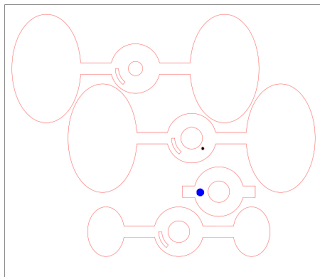Submissions are due by the end of the day on Monday, October 2nd. Make sure to scan your work and put it in your Mathematics/POW folder with a name of LASTNAMEWeek3. See me with questions. You may work with a partner but make sure you note that on your submission and you both must submit a copy for credit. You also must explain your process and solution in sentences!
Sunday, September 24, 2017
Thursday, September 21, 2017
Helicone - A Laser Cut Version
The Golden Ratio Project - Phyllotaxis on a Laser Cutter
I went through multiple prototypes, some of which neared completion before determining that the mechanism or materials were not strong enough. I also had to flip the rotating mechanism so that the input would be from the base and not from the top of the helicone. Early iterations used rivets and slots to trigger and limit the rotation but these ended up bending or getting ripped from the wood after continued use.
This seemed like the most obvious method when I started this project. I found hollow brass rivets on Amazon and designed the mechanism with the pin poking through the top layer of each. The golden angle was relatively easy to calculate and designs were made on Inkscape to have a slot on the bottom of each layer to create a helix and a golden ratio "rush". I designed many, many files so that each layer could be cut separately.
Problems discovered: Wood layers will warp when using wood glue. Warped layers consequently interrupt the smooth operation of the helicone. Also, the helicone seemed to worked best when engaged from the top layer which seemed a bit akward.
Prototype 2 - Acrylic, Rivets and Tapered Branch Lengths
Acrylic took care of the warping issue but rivets did not fit perfectly and would still get ripped out when the helicone was spun at high speeds. Acrylic is also much more expensive and requires the use of hazardous materials to fuse together. On the plus sides, the look of the material both the color and rastering results is impressive (may do another of these in the future).
Prototype 3 - MDF, Rivets and Tapered Branch Lengths
MDF is hard to find but I finally found a supplier through Etsy. Great material to work with but the edges are not particularly strong (weaker than plywood) and it became clear that rivets were not going to be the right mechanism. I made about 12 layers with MDF before punting on this idea and almost quitting on the project.
I considered an idea of using wood itself for the mechanism after seeing an example of a helicone made on a 3D printer. The benefit of this "bow-tie" design is that the mechanism has better symmetry and distributes the forces on each side of spinner. I also liked that it did not require special order rivets and only required screws (#4 x 3/8") for construction. During this last prototype, I also learned more about the use of adhesives. Spray adhesive works well for large flat layers and provides a fast even coating with adequate attachment. For the more critical pieces, such as the bow tie and pedal connectors, I still use wood glue and allow time for setting.
During this prototype I also decided to streamline the constructions process and files. I made one file for printing 6 spinner mechanisms but did not include the pedals. This allowed me to fine tune the design for checking the mechanism and also used the sheets of material more efficiently. The pedals for each layer are cut separately and attached with wood glue and take advantage of a "puzzle piece" connector. I also think this design results in less warping as each layer uses multiple pieces of wood rather than long pieces from one piece.
After finding success with this last design, I focused on how to make it interactive. I spent some time cutting sprockets from both wood and HDF but it became clear that bike chains exert tremendous force on the material and require the use of metal sprockets. A quick visit to the Harris Cyclery in West Newton (and $20) and I had the front and rear sprocket as well as a matching chain. I cut some additional plywood pieces on the laser cutter to match these sprockets and added the same 22mm bearing to allow for smooth actuation. I also learned how to break a chain and use a connecting link to adjust the chain to the proper length.
What's next? Another version? Possibly. I still like acrylic but question it's ability to withstand the forces and torque.
Sunday, September 17, 2017
POW #2
Submissions are due by the end of the day on Monday, September 25th. Make sure to scan your work and put it in your Mathematics/POW folder with a name of LASTNAMEWeek2. See me with questions. You may work with a partner but make sure you note that on your submission and you both must submit a copy for credit. You also must explain your process and solution in sentences!
Subscribe to:
Posts (Atom)




